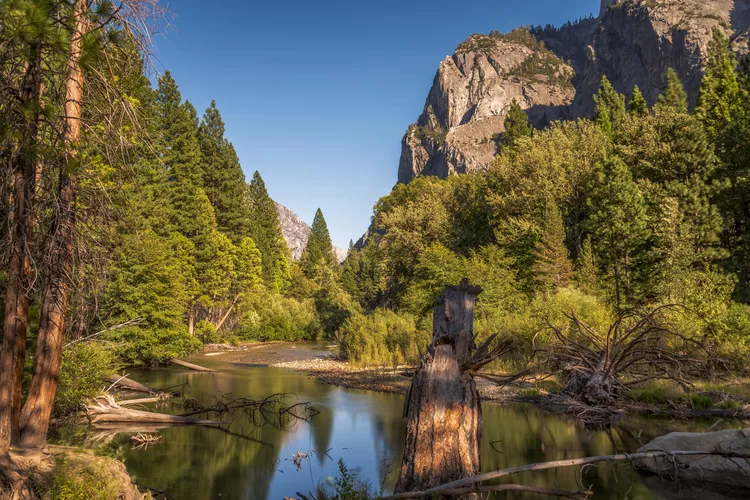Summary
- General Grant National Park (Three Rivers, California)
- Platt National Park (Sulphur, Oklahoma)
- Sullys Hill National Park (Fort Totten, North Dakota)
- Hawaii National Park
- Mackinac National Park (Mackinac Island, Michigan)
- Fort McHenry National Park (Baltimore, Maryland)
- Abraham Lincoln National Park (Hodgenville, Kentucky)
The United States is fortunate to have a National Parks Service (NPS) that allows us to experience some of North America’s most stunning locations. While you might already have a list of national parks to visit, consider adding these seven former national parks to your travel itinerary; they’re worth a visit.
General Grant National Park (Three Rivers, California)
Formerly: General Grant National Park
Currently: Sequoia and Kings Canyon National Parks
The NPS oversees both of these parks due to their geographical proximity. Given the abundance of California parks, merging them has made management and promotion much simpler.
Originally established in 1890, General Grant National Park was aimed at protecting the region’s sequoias from extensive logging activities. Activist John Muir played a crucial role in raising awareness about the beauty of these colossal trees and the threats posed by logging. Efforts to preserve both Sequoia and Kings Canyon National Parks continued throughout the 1960s.
Platt National Park (Sulphur, Oklahoma)

Formerly: Platt National Park
Currently: Sulphur Springs Reservation
Established in 1902, Platt National Park was originally called the Sulphur Springs Reservation. The park opened to the public in 1904 but was absorbed into the Chickasaw National Recreation Area (CNRA) in 1976.
Located in the Arbuckle Mountains of Murray County near Sulphur City, the CNRA features pavilions, park buildings, and extensive options for outdoor activities such as kayaking, boating, and camping. This beautifully preserved area offers insights into the Chickasaw Indian Nation, making it a delightful destination for travelers.
Sullys Hill National Park (Fort Totten, North Dakota)

Formerly: Sullys Hill National Park
Currently: Sullys Hill National Game Reserve
This area transitioned from a national park to a national game reserve, losing its status as a park in 1931 when the NPS shifted oversight. The management of the reserve is now under the Fish and Wildlife Service, focusing on hunting and fishing activities.
Sullys Hill National Game Reserve boasts wooded hills and marshlands, home to American bison, elk, deer, and prairie dogs. Birdwatchers frequently visit, and the on-site visitor center offers educational exhibits about the local wildlife and history, making it a must-visit destination for outdoor enthusiasts.
Hawaii National Park

Formerly: Hawaii National Park
Currently: Hawai’i Volcanoes National Park & Haleakala National Park
In 1960, Hawaii National Park was divided into two national parks for more manageable oversight: Hawai’i Volcanoes National Park and Haleakala National Park. The NPS determined that separating the parks based on their vast geographic areas would enhance management efficiency.
Hawai’i Volcanoes National Park hosts Kilauea and Mauna Loa, two of the world’s most active volcanoes. Visitors can reach the summits and learn about their geological impacts. For a truly unique experience, plan a visit to the active volcanoes on the big island of Hawaii.
Haleakala National Park, on Maui, encompasses over 33,000 acres and features the Haleakala Crater, renowned for its landscape. The summit is a challenging climb, rewarding those who make the journey with breathtaking views and insights into volcanic activity.
Mackinac National Park (Mackinac Island, Michigan)

Formerly: Mackinac National Park
Currently: Mackinac Island State Park
Established in 1895, Mackinac National Park was one of the first national parks in the U.S. and transitioned to state oversight just two decades later. Less than four square miles are encompassed within Mackinac Island State Park, with over 70 percent of the area being water. Significantly, the island prohibits cars to enhance the natural experience for pedestrians.
Historical sites such as Fort Mackinac and Fort Holmes provide visitors with insights into the rich history of the region. Unique limestone caves and rock formations further enrich the landscape. Remarkably, the island welcomed its 20 millionth visitor in 2009, celebrating a long history of popularity despite the change in status from national to state park.
Fort McHenry National Park (Baltimore, Maryland)

Formerly: Fort McHenry National Park
Currently: Fort McHenry National Monument
Originally established in 1925, Fort McHenry National Park transitioned to a national monument in 1939, thus becoming Fort McHenry National Monument and Historic Shrine. This site holds significant historical value, as it inspired “The Star-Spangled Banner.”
Located in Baltimore, Maryland, Fort McHenry defended the harbor during the War of 1812, where its soldiers repelled an attack by the British Navy. The flying storm flag during bombardments inspired Francis Scott Key to pen the poem that eventually became America’s National Anthem, making this location a pillar of American history.
Abraham Lincoln National Park (Hodgenville, Kentucky)

Formerly: Abraham Lincoln National Park
Currently: Abraham Lincoln Birthplace National Historic Park
Designated as a national park in 1916, President Abraham Lincoln’s childhood home later became known as the Abraham Lincoln Birthplace National Historic Park after the NPS disbanded it in 1939. This historic park encompasses two farm sites in LaRue County where Lincoln was born and raised.
The park features a visitor center at Lincoln’s childhood home, providing information about the 16th President of the United States. Additionally, the Nancy Lincoln Inn offers accommodations for road trippers. A replica of the log cabin where Lincoln is believed to have been born highlights the historic significance of this site, making it an essential stop for those interested in learning more about the life of President Lincoln.





